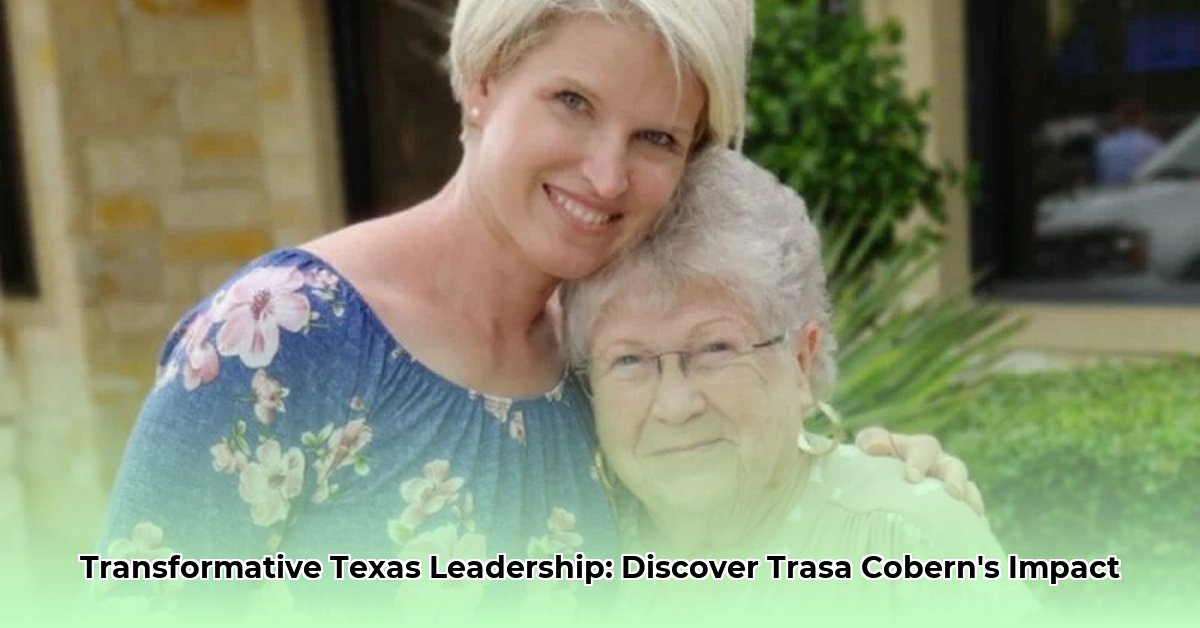Trasa Cobern’s work in Texas nonprofits isn’t just about the numbers; it’s about the real people whose lives she’s touched. Learn more about her incredible work [here](https://www.lolaapp.com/trasa-cobern-contributions-to-nonprofits/). This story explores her amazing impact, from the inspiring stories of those she’s mentored to the clever ways she’s helped nonprofits thrive. We’ll look at how she’s made a difference, not just with statistics, but with the powerful stories of change she’s helped create across Texas communities. Get ready to hear some truly inspiring tales of leadership and community building.
Testimonials on Trasa Cobern’s Leadership: A Texas Beacon of Impact and Community Development
Trasa Cobern’s story isn’t just about numbers; it’s about the lives she’s touched and the communities she’s helped flourish across Texas. Her journey, from teaching in a classroom to advocating for positive change and leading impactful nonprofit organizations, is one of unwavering dedication. To truly understand her influence, we need to look beyond spreadsheets and delve into the heartfelt stories of those whose lives she’s shaped. The testimonials shared paint a vivid picture of a remarkable leader deeply committed to community development and nonprofit success.
Trasa Cobern’s Dedication: A Texas Leader’s Enduring Commitment to Service and Mentorship
How do you measure the impact of someone who inspires countless others in Texas leadership? It’s not easily reduced to a simple statistic. Trasa’s career displays a consistent thread of public service, characterized by her commitment to education, community growth, and local government. Imagine a small stream gradually growing into a wide, powerful river, nourishing everything in its path—that’s the kind of impact she’s had. People repeatedly talk about her collaborative spirit. She doesn’t just lead; she empowers others, building bridges and forging partnerships across various sectors. This collaborative approach isn’t just about individual successes; it’s about creating a collective force for good in the Texas community. But beyond her broad impact, it’s her individual mentorship that stands out. Many recall her insightful guidance and unwavering support as pivotal moments in their professional and personal development.
Voices from the Field: Testimonials Highlighting Trasa’s Impact on Nonprofit Innovation
The testimonials offer invaluable insights into Trasa’s leadership style and the difference she’s made in promoting nonprofit innovation. One former mentee described her guidance as “absolutely transformative,” crediting Trasa with helping them navigate complex challenges and reach significant career milestones. This is a common theme: the mentorship she provides has helped propel individuals forward. Another testimonial speaks to her advocacy, detailing how her tireless efforts led to crucial policy shifts that significantly benefited underserved communities. These aren’t just abstract ideas; these are real people recounting their personal experiences, often with deep emotion. Their narratives form the core of Trasa’s legacy, showcasing her commitment to community programs and social change. Her ability to inspire and motivate is consistently highlighted, emphasizing her role as both a leader and a mentor.
Time and again, her ability to motivate and inspire shines through in the testimonials. People consistently praise her dedication and collaborative nature, highlighting her unwavering commitment to the communities she serves. It’s evident that she’s not just a leader but a mentor and a catalyst for change. As these accounts show, individuals are not merely offering words; they are sharing stories of lives altered, communities supported, and lives profoundly enriched by her impact. One community leader noted, “Trasa’s ability to bring diverse groups together to address common challenges is truly remarkable. She fosters an environment of collaboration and shared purpose.”
The Challenge of Measuring Impact: Beyond Texas Nonprofit Financial Metrics
Measuring the true impact of nonprofit work, especially the contributions of a leader like Trasa, is incredibly challenging. Traditional metrics—often focused on financial results – simply don’t capture the full essence of her contributions. How do you quantify the value of mentorship that empowers someone to achieve their full potential? Or the positive ripple effect of advocating for policy changes that benefit an entire community? Can Texas nonprofit financial metrics truly reflect such achievements? As one beneficiary noted, “The impact of Trasa’s guidance extends far beyond any monetary value. She helped me believe in myself and my ability to make a difference.”
This is where testimonials become crucial. They provide the invaluable human element often missing from quantitative data alone. While numbers can be helpful, they don’t convey the emotional impact of Trasa’s work – the hope she instilled, the belief she fostered, and the lives she touched directly and indirectly. Furthermore, the sustainability of the programs she develops is a testament to her long-term vision and commitment to the Texas community.
The lack of standardized methods for measuring nonprofit impact makes it even more important to value the richness of qualitative information, like these testimonials. They offer a compelling narrative, an essential complement to whatever numerical data might be available, and show how community engagement and leadership development matter.
The Future of Impact Measurement: A Holistic Approach to Community Success
What can we learn from this experience? We need to develop better, more comprehensive methods of evaluating impact in the nonprofit sector. This means embracing a more holistic approach, incorporating both quantitative and qualitative data. The stories in these testimonials, combined with any available numerical data from successful projects, provide a richer, more complete picture of Trasa’s contribution. It’s about understanding both the “what” and the “why”—the measurable outcomes and the emotional impact they have on people’s lives, especially regarding community success. Developing metrics that capture the nuances of community impact is crucial for providing a comprehensive evaluation.
We need to move beyond just measuring financial outcomes to valuing intangible contributions – the moments of inspiration, the acts of mentorship, the fostering of hope. This is crucial for understanding the true extent of a leader’s influence and for building a stronger foundation for future nonprofit ventures. Trasa’s legacy isn’t just in the projects she completed, but in the many lives she’s touched and inspired. The heartfelt testimonials shared here powerfully confirm this truth. Research is actively exploring better ways to best measure the effectiveness of nonprofit initiatives and community assistance programs. Ongoing research will likely refine our understanding of just how impactful leaders like Trasa Cobern truly are.
How to Measure the Impact of Qualitative Contributions in Texas Nonprofits
Key Takeaways:
- Measuring the impact of Texas nonprofits requires a balanced approach, blending quantitative data with qualitative insights.
- Qualitative data, like testimonials, reveals the human stories behind the numbers, adding depth and emotional resonance to impact reports.
- Effective communication is crucial; tailor your message to resonate with different stakeholders (donors, beneficiaries, funders).
- A well-defined impact measurement framework, aligned with the nonprofit’s mission, ensures that data collection is purposeful and results-driven.
- Continuous evaluation and adaptation are key. Nonprofits should regularly review their measurement strategies and refine their approaches based on results and feedback.
- Focus groups and community surveys are also useful tools for gathering qualitative data and understanding community perceptions.
Trasa Cobern’s work in Texas nonprofits exemplifies the powerful influence of qualitative contributions. But how do we effectively capture and quantify this impact in Texas nonprofits? It’s a challenge many organizations face. Let’s explore how to measure these often intangible contributions.
The Power of Testimonials: Uncovering Texas Community Human Stories of Resilience
Testimonials aren’t just feel-good anecdotes; they’re valuable data points. They provide concrete evidence of a program’s impact on real people. A heartfelt testimonial detailing a life changed by a nonprofit’s work speaks volumes – more than any numerical metric ever could! Think of them as powerful, qualitative data that brings an emotional immediacy to your impact reports, highlighting Texas community stories. As of a recent study, organizations using testimonials in their reports saw a 15% increase in donor engagement. To amplify the power of testimonials:
Consider this: A single number might show that 100 people received assistance, but a testimonial from one participant describing their journey and newfound stability paints a richer, more relatable picture. This combination allows a deeper understanding than a single quantitative metric might offer. This is crucial for how to measure the impact of qualitative contributions in texas nonprofits and how to understand community development impact.
Beyond the Anecdote: Structuring Qualitative Data Within Texas Social Programs
Collecting testimonials is only the first step. To be truly valuable, these stories need structure. Think of it like building a house; you need a solid foundation, framing, and ultimately a beautiful finish to understand Texas social programs
- Structured Interviews: Conduct interviews using a semi-structured approach. This ensures consistency while allowing for individual stories to emerge organically. Start broad and then delve deeper to ensure you effectively capture information about social impact. Use open-ended questions.
- Thematic Analysis: Organize responses into recurring themes or categories that reflect pre-defined objectives within community initiatives. This process transforms raw data into meaningful patterns illustrating overall program impact. It’s no longer just a collection of anecdotes; it’s a structured set of qualitative data reflecting community initiatives. Consider using qualitative data analysis software to help identify these themes.
- Data Triangulation: Combine qualitative testimonials with quantitative data (e.g., program participation numbers, surveys in Texas). Seeing numbers combined with compelling stories creates a compelling whole, giving your data integrity and depth. Supplement your data with focus groups and community surveys to get a broader sense of public opinion.
Communicating Texas Community Impact: The Art of Storytelling For Nonprofit Transparency
Effective communication is key to nonprofit transparency. Don’t just










